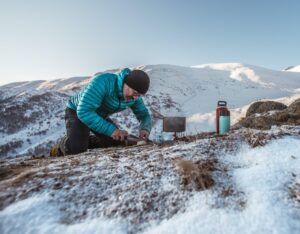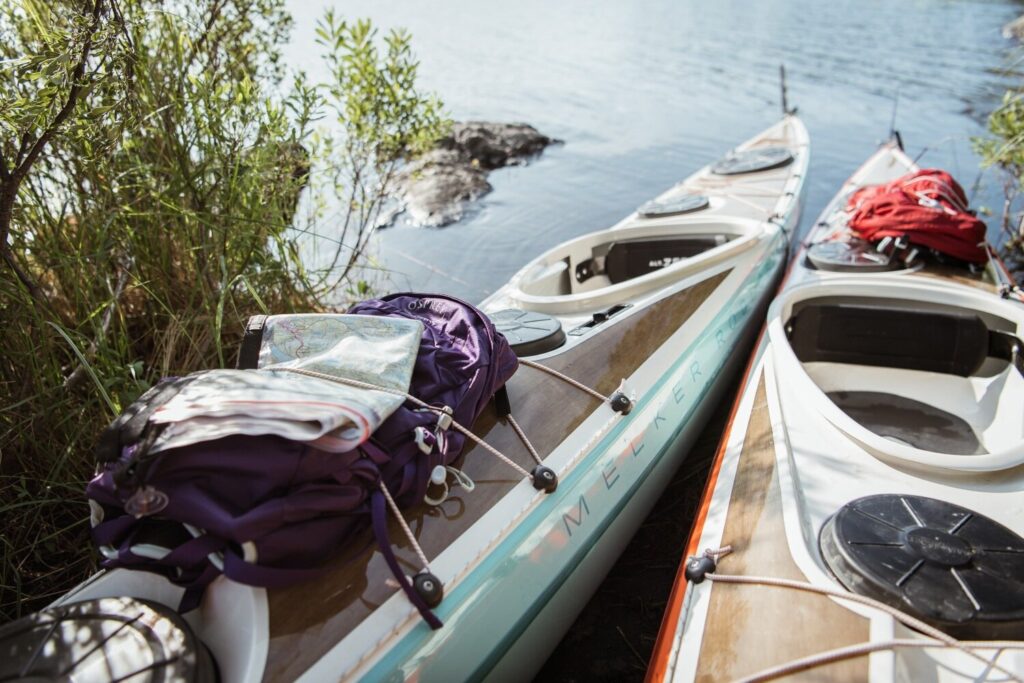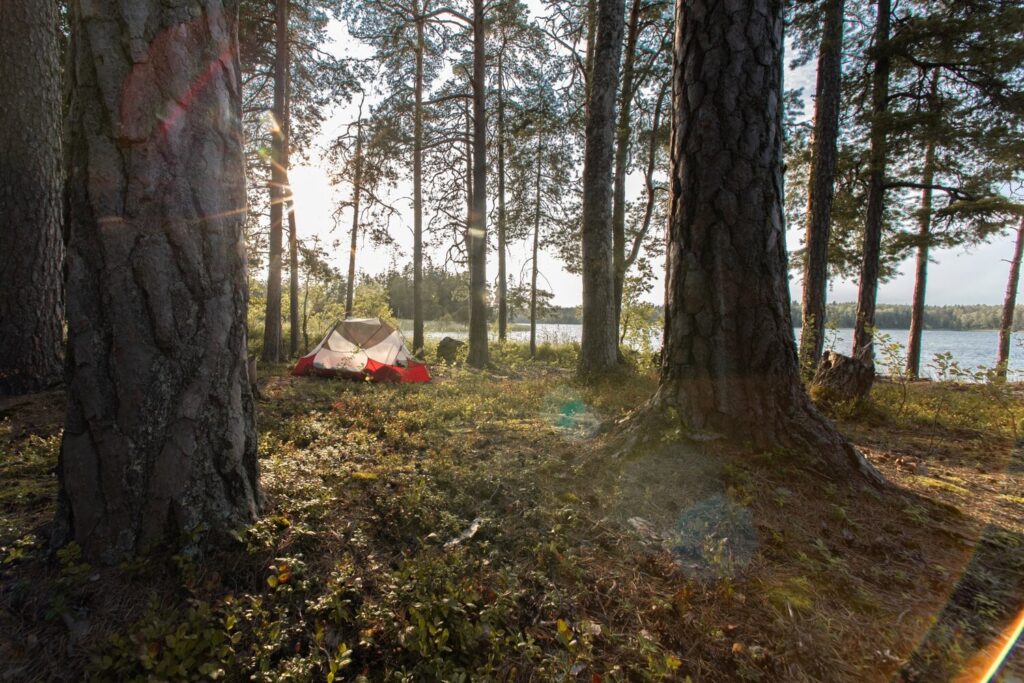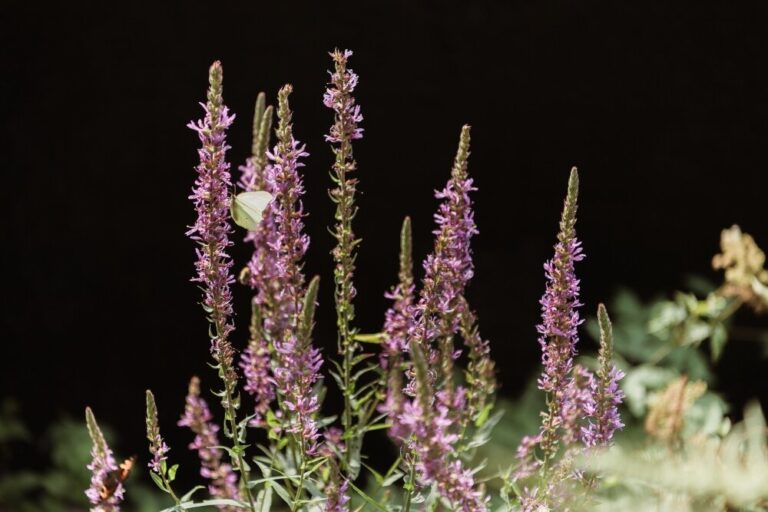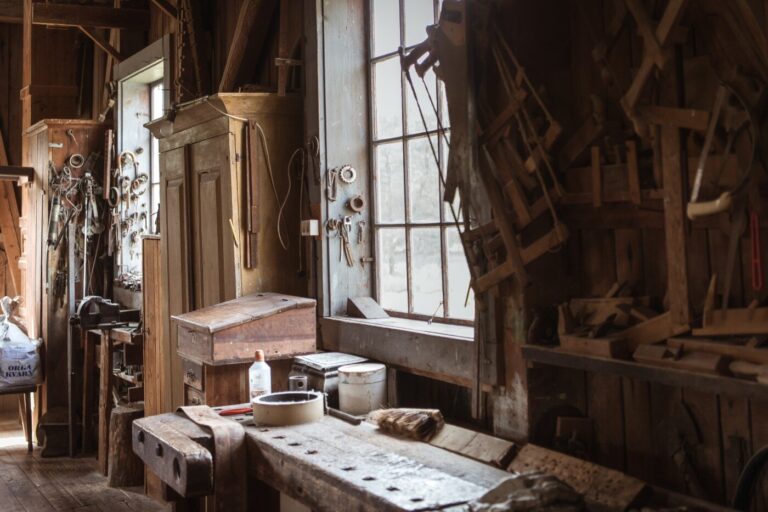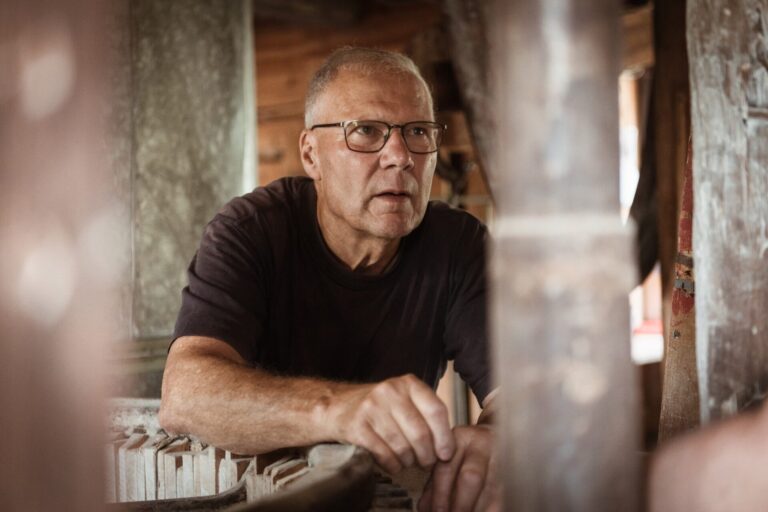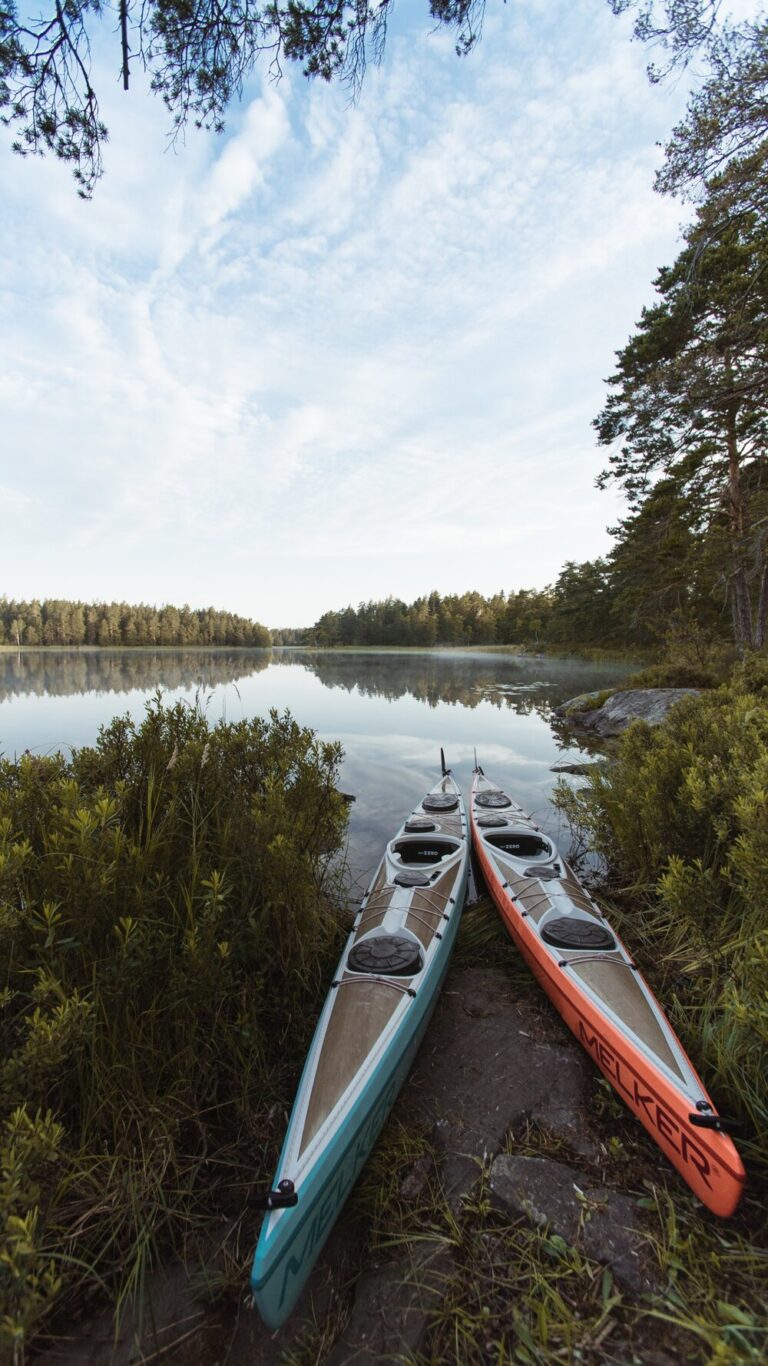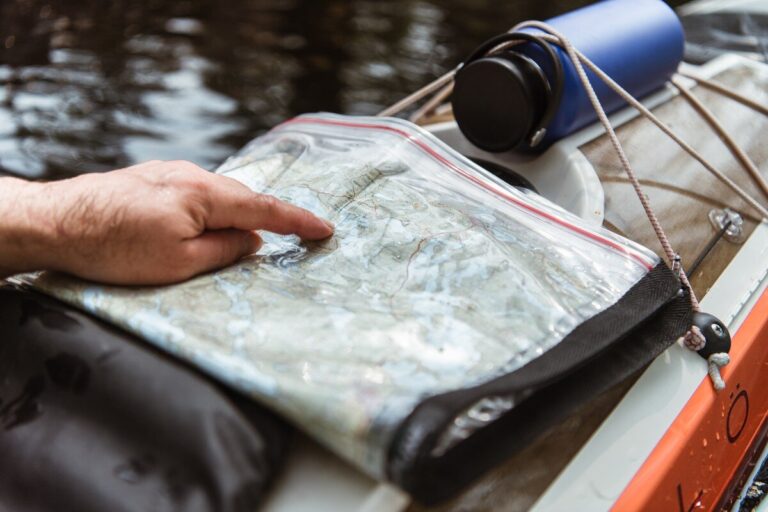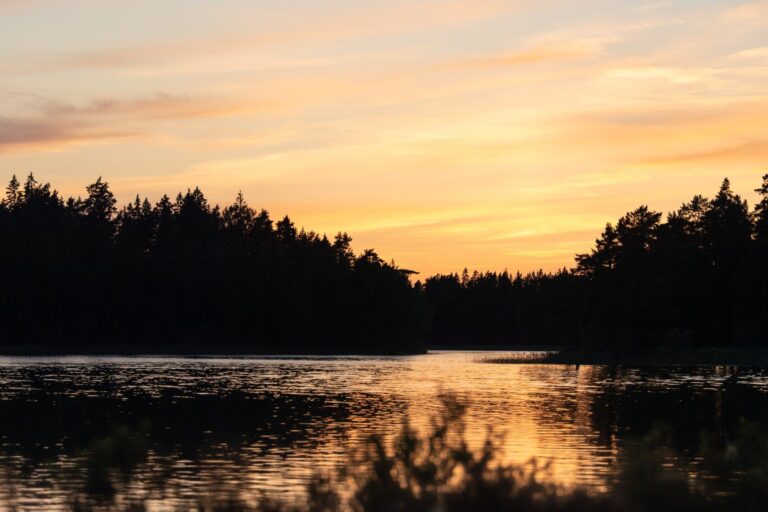Home Story Calm Waters, Islands and Hidden Creeks
Calm Waters, Islands and Hidden Creeks
Feature type Story
Read time 13 min read
Published Aug 25, 2021
Author Kieran Creevy
Photographer Lisa Paarvio
Dense forest hems us on both sides, sun flickering in streaks of light. Gravel and twigs crunch under tyres. Behind us, nestled in foam lie two hulls of kevlar and carbon, our transport for the next four days. Unloading the trailer and pickup, we lay our dry-bags, duffles and food supplies. Our kayaks loaded with care, Johan proposes an interlinked set of lakes, creeks and rivers for our journey. We listen intently. He’s a local wilderness expert with more than 40 years experience. His words are precise, chosen with the care that comes from a lifetime lived outdoors.
Packing the map away in a waterproof cover, we wriggle into the cockpits, and finalise our meeting point, four days hence.
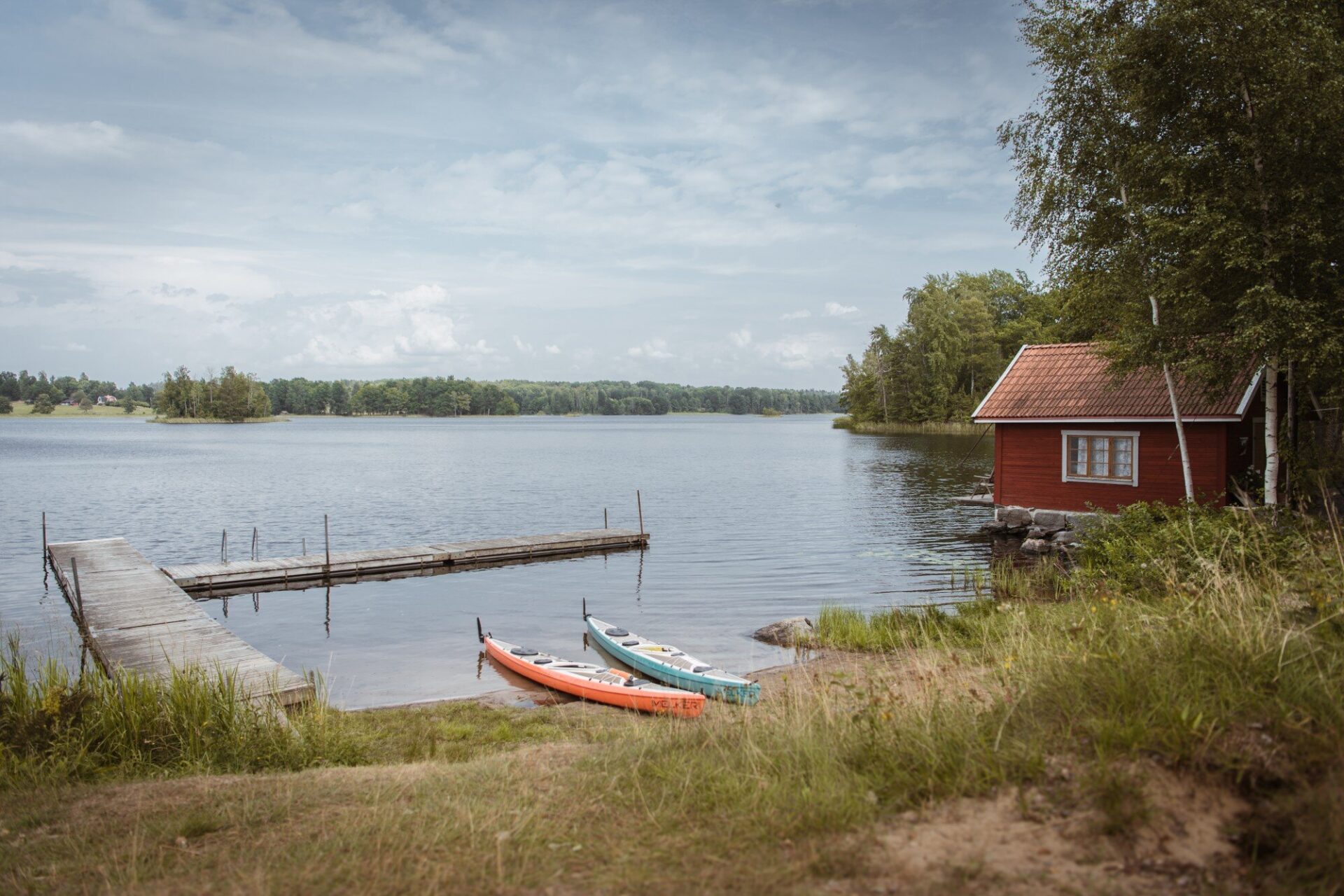
Dark water flows over the bows of our kayaks as we glide down the bank. Slipping into the liquid medium, our pace alters. No longer rapid motions, but something languid, more akin to a yogic flow. Core, back and arm muscles work in concert. Catching, pulling, and feathering, each dip of a blade propels us forward, skimming over unseen depths.
Wildlife abounds; a water-dance of loons dive in search of fish, dragonflies buzz around our kayaks, and somewhere below us flit shoals of perch, bream and pike. We navigate our way through the myriad of inlets and sheltered coves, grateful for the opportunity to travel and explore again as a team.
A scream cuts through our daydreams. Instantly, we’re on high alert, eyes scanning the skies above for a sign of the osprey we’ve just heard. It’s close, no more than two hundred metres away, wings cupping the air as it comes into land. We paddle into a thicket of reeds on a nearby island, beaching our kayaks. In seconds Lisa’s out of the cockpit, waterproof pack in hand with her cameras. Perched high in the canopy of a sparse pine, the raptor’s nest is in the perfect spot. Camouflaged by their downy feathers, two chicks are almost completely hidden. The sole signs that they’re even there are tiny movements, visible only with a zoom lens
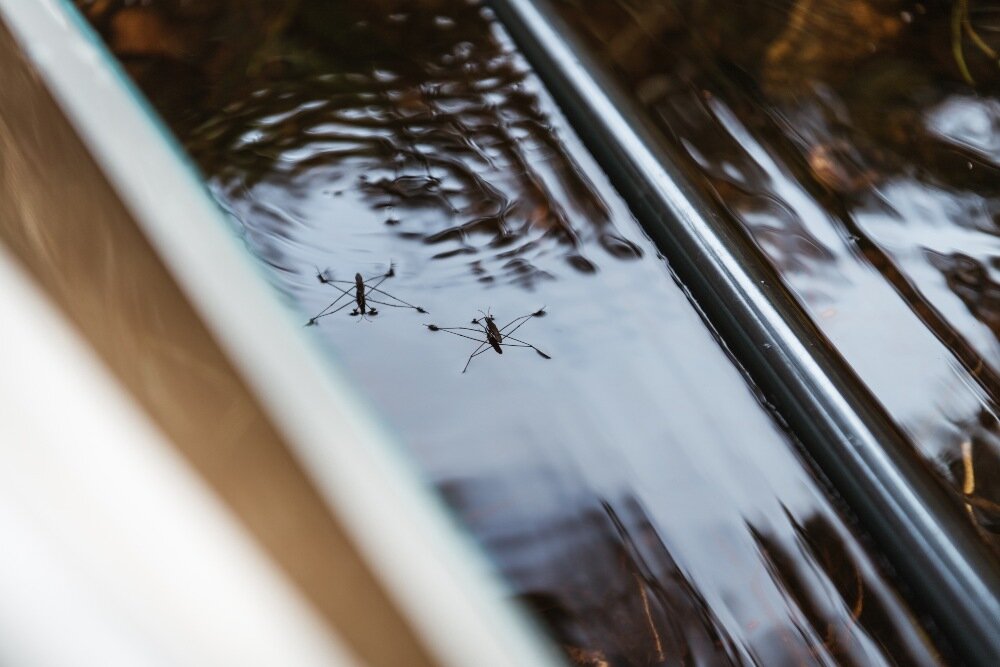
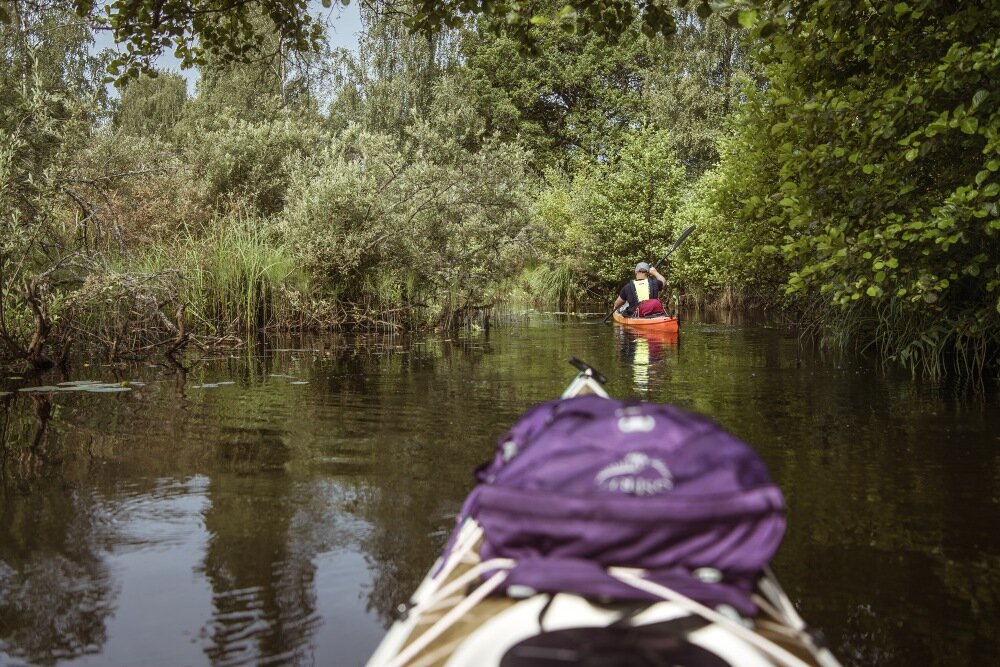
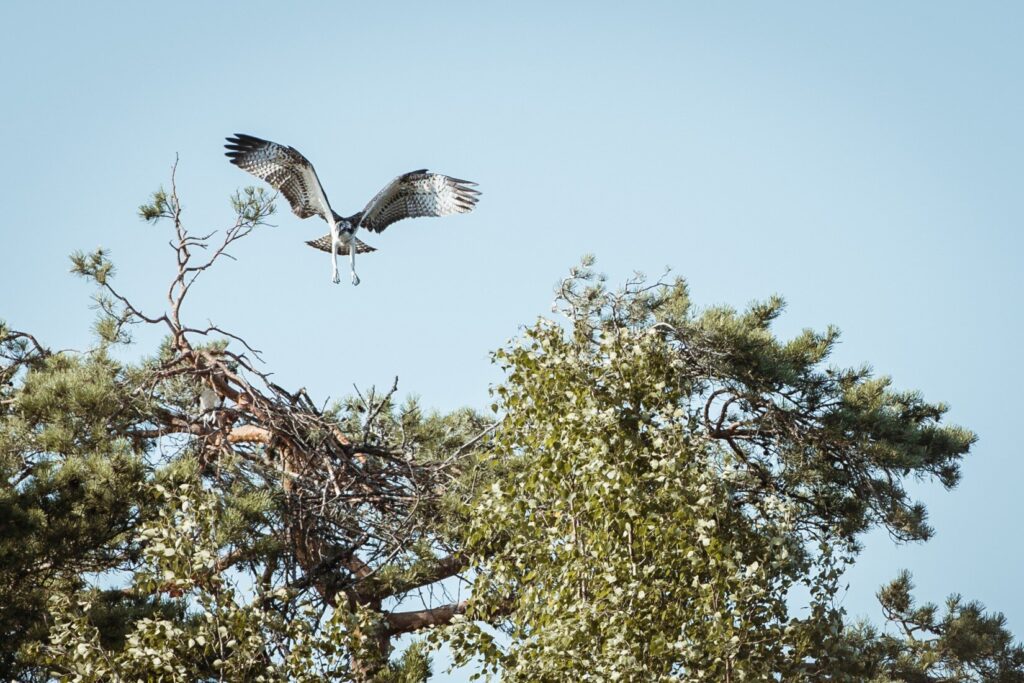
Photos captured, it’s time to leave the birds in peace. We take a looping course, careful not to intrude too close to their tiny island. We’re on the water no more than a half day, but already the wilderness and rhythmic exercise has put paid to any minor cares. We’re immersed in the present, the only task in the next few hours is to find a wild camping spot.
Rounding a spit of land a few hours later, we find the perfect space. Gently shelving banks make it easy to land, and in the clearing is a tiny scrap of flat ground, just enough for our tent. Our lives get stripped back to the essentials; cooking, eating, sleeping, washing, exercising. Our phones are there for alarms and quick location updates only.
The next morning, our alarms become superfluous.
‘What the hell! It’s only 5am!’
The slanted light has hit Lisa squarely in the face. I’m on the other side of the tent, so have a tiny element of shade, but she’s right. It’s too damn early! More sleep is now impossible.
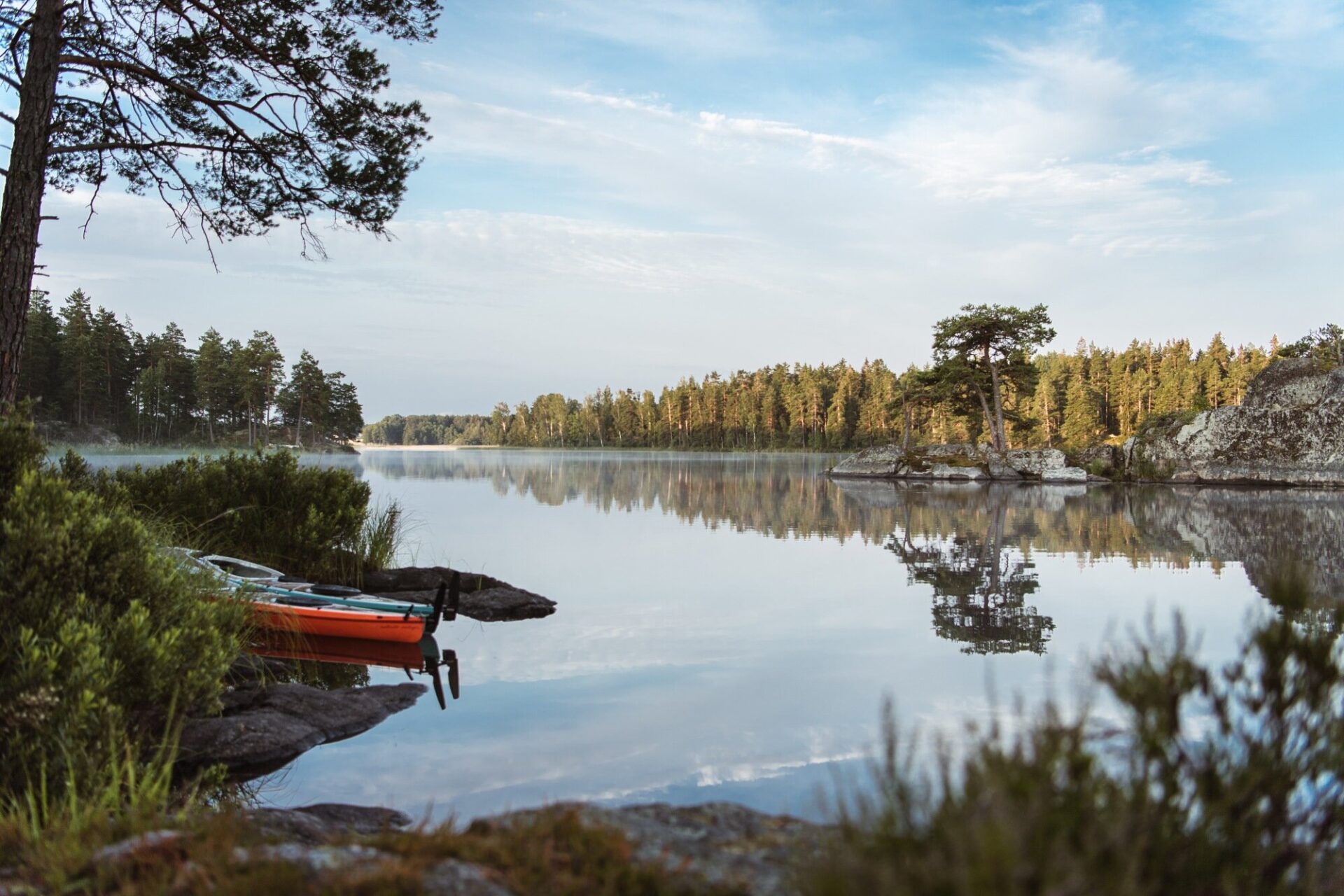
With no flysheet overhead, we have an unobstructed view all around us. Twenty metres away, the lake is millpond calm, shades of gold and blue reflected in its surface. We’re itching to pack up and slide our kayaks into this liquid mirror. Unfortunately, between us and our goal, lie a hoard of thousands, hungry for our blood. They hover mere millimetres away, wings whining plaintively. Locked in a detente, separated by gossamer mesh, we wait for the first signs of wind.
Ripples appear on the lake, shattering the mirror calm. With the wind, it’s safe to leave the tent, and get on with our day. First order, coffee, breakfast and a morning dip. With the summers warmth, the lake is a balmy 23ºc. Fast broken, in dry clothes and kayaks packed it’s time to move on.
Snapping spraydecks tight onto cockpit rims, we slide quietly off our overnight camp, back exploring. Each curve in the lake, creek, and island gifts us with new experiences and memories: Foraging for tiny wild bilberries metres from the shoreline.
Building a small, safe, bushcraft fire from scratch. Trying to learn how to fish with rod and reel, and making a total mess of this essential skill. Talking late into the evening, the northern latitudes granting us with light far into the night.
Mid portage between two of the lakes we come across an imposing stone and wood building. It’s massive wooden corner posts, gnarled and darkened with centuries of wear. We want to find out more about this place, but it’s shut tight.
Just as we’re about to give up, the local postal delivery arrives. Barn doors creak open, the scent of freshly ground rye, barley and spelt wafts out. It’s a water powered mill. Speaking with the owner, it’s obvious he views his job and livelihood as but one part in a long chain. He’s the fifth generation of millers, his great, great grandparents having bought the mill from the previous custodians and millers more than 150 years previously.
We don’t fill our houses, apartments, or offices with trash, so why is it deemed acceptable to do so to our wild places?
On the last afternoon, with thunderclouds fast approaching, we battle hard to make headway up the lake. Little ripples morph into waves, their flow pushing hard against our hulls, necessitating full rudder lock to stay on course. A hundred metres from shore and the wind dies, we’re in the lee of the land, protected. Gliding onto a sandy beach, our water journey ends.
Driving back to Johan’s farm, and a night in a handmade wooden off-grid cabin, we can’t help but be amazed and impressed with how lucky we were to have traveled across such a pristine environment.
On our journey, we were less than forty-five minutes drive from a big city and only ten or twenty kilometres from the nearest village, but there was no sign of plastic trash, cigarette butts or food scraps littering the banks of the lake. This is how all our wild spaces should be. We don’t fill our houses, apartments, or offices with trash, so why is it deemed acceptable to do so to our wild places?
Coming from Spain, Lisa and I can see the positive impact that Allemansrätten (the right of public access) has on the landscape and the people. The people have an emotional investment and obvious respect for the land, and treat it with the care it deserves. As a result, they are granted legal rights that don’t exist in many other countries.
That leads to an interesting chicken and egg question. Which comes first? Treat the land with care and respect and be granted rights to public access, or be granted rights, then act responsibly? I would argue that the former creates a deeper investment from us, and is harder, but offers a longer lasting solution.
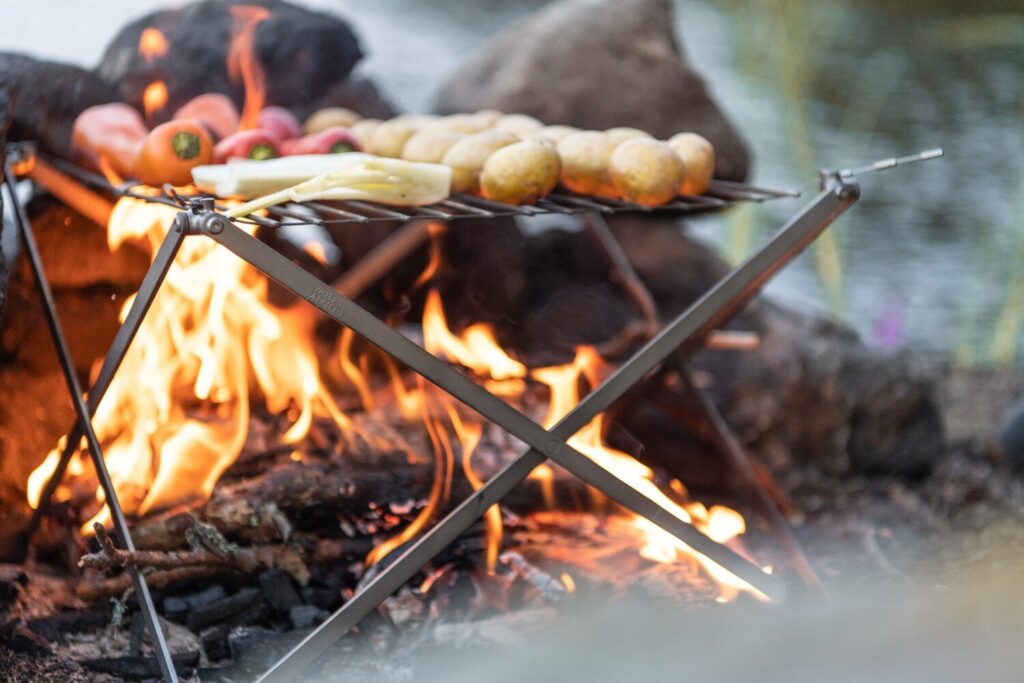
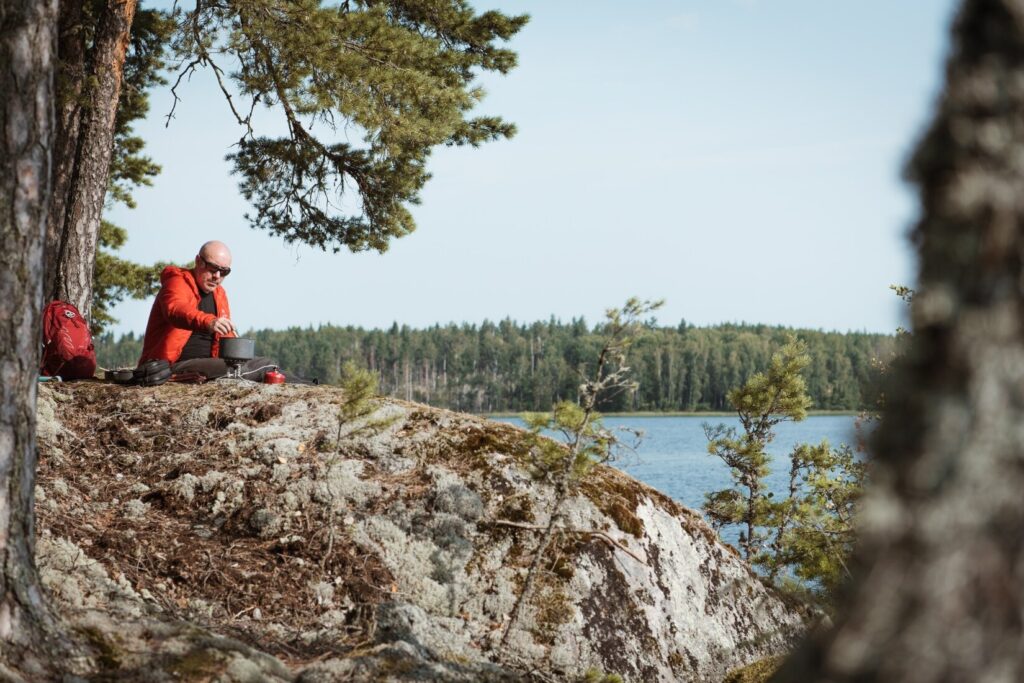
Making Fire Outdoors
For the full experience, try to cook these dishes over an open fire or on a barbecue. Obviously, if you’re making an open fire in the outdoors you need to follow a few very important rules.
-
You either need permission to have an open fire or have checked with local regulations.
-
You only really need a side plate to dinner plate size fire to cook these dishes below, any larger and you’re just using extra fuel for no immediate gain and you may exhaust usable wood in that area.
-
If you’re cooking over an open fire make sure the wood you’re using isn’t going to impart an unpleasant taste to your food. For preference therefore I’d recommend Apple, Ash, Beech, Birch, Crabapple, Chestnut and Oak.
If you’re cooking over an open fire, moderate the heat imparted to the food allowing the wood to cool to coals or by height/distance – the higher/further you are above/away from the fire the lower the heat. This might sound obvious, but you’d be amazed at how many people stick skewered sausages directly into a flame, blackening the skin yet undercooking the insides.
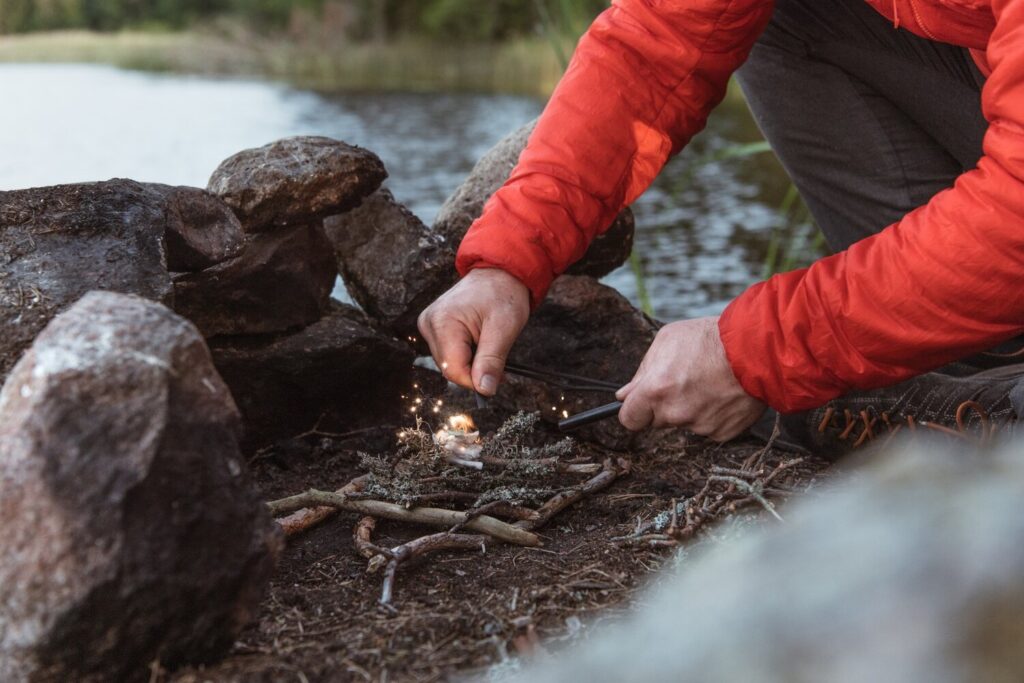
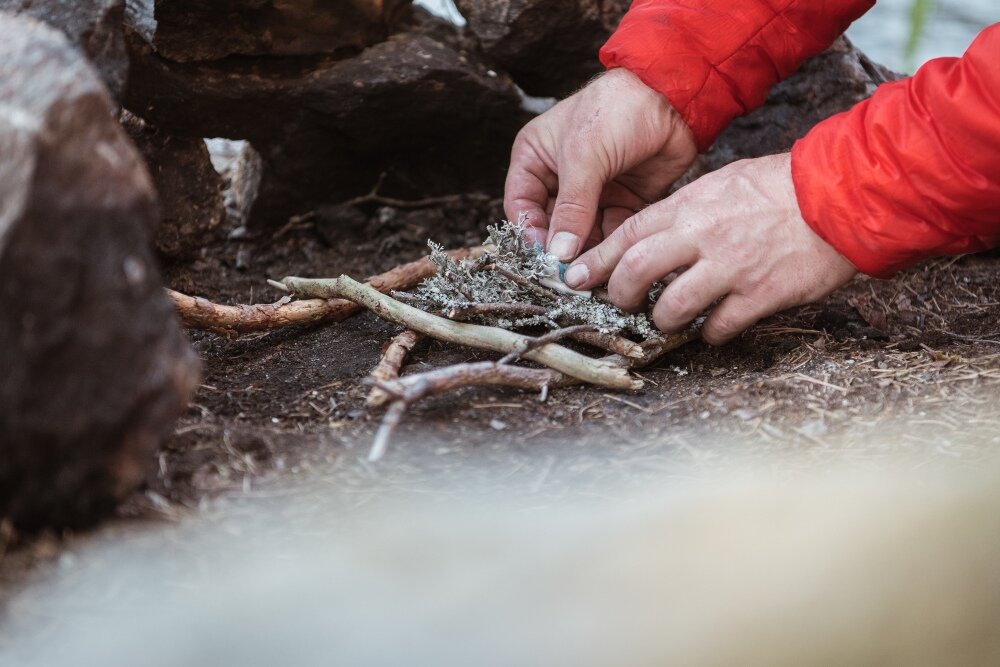
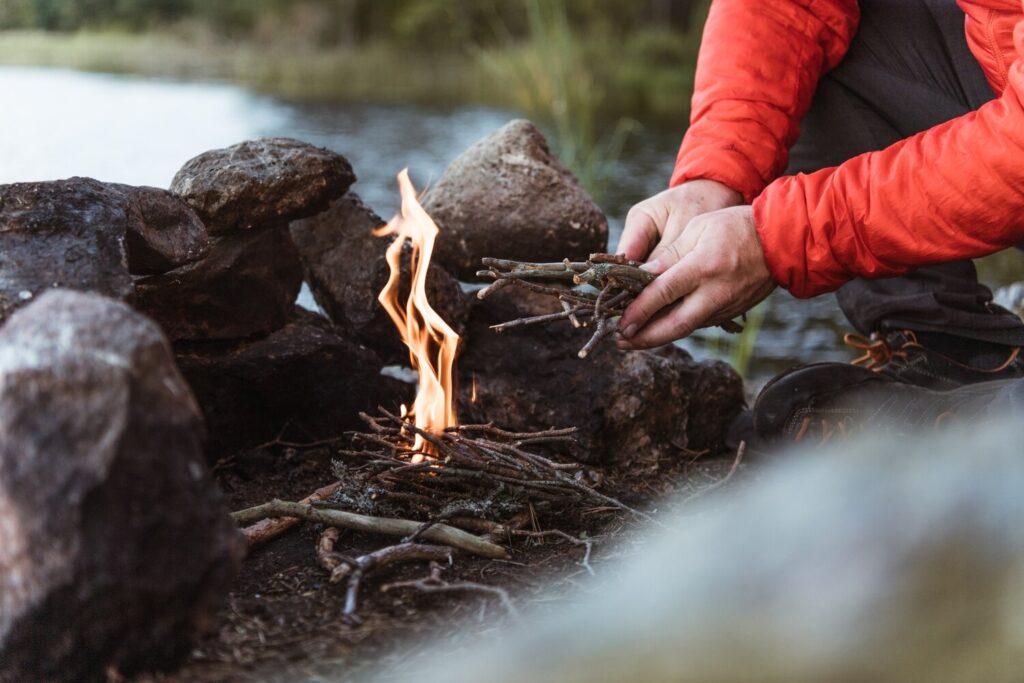
General Foraging Advice
Permission:
*Make sure you are legally allowed to forage in that particular area, of if you’re on private land, get permission from the landowner.
Identification and Knowledge: Positive identification and knowledge of the plant is essential
-
Knowledge of which plants/fruits/nuts are edible and how to correctly identify them.
-
Only harvest if you can correctly identify the plant and the surrounding area is not contaminated.
-
Many plants are highly poisonous and can cause death if consumed and many edible plants have poisonous look-a-likes.
-
It’s important to know which part/s of each plant are edible.
-
Some plants are only edible after careful preparation e.g. Cooking, washing, removal of sections.
-
Some plants are only edible at specific times of the year/growth cycle.
Sustainable harvesting: Where, when and how to forage:
-
Only pick when a plant is abundant.
-
Use sharp scissors for preference, or a sharp knife.
-
Only harvest in patches, as you need to leave plants for regeneration and its continued survival.
-
Try not to remove flower or seed heads unless sourcing these specifically.
-
Plants form a vital part of the eco-system, and many animals, insects and other organisms rely on them for survival.
The Law:
* Familiarise yourself with the law regarding wild plants as some species are protected due to being rare, fragile, under threat or form a vital part of the ecosystem.
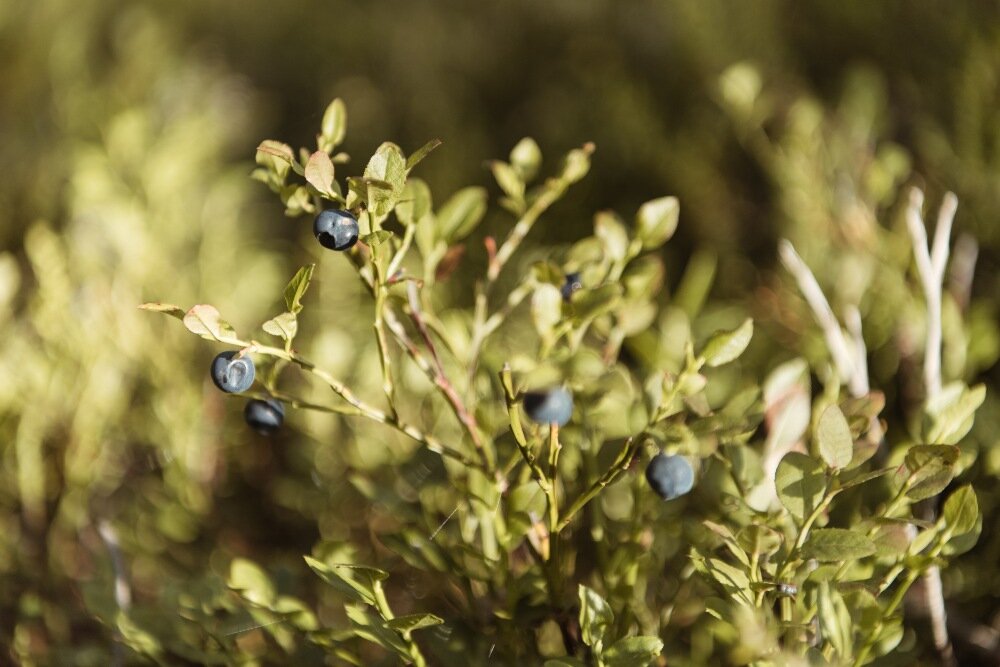
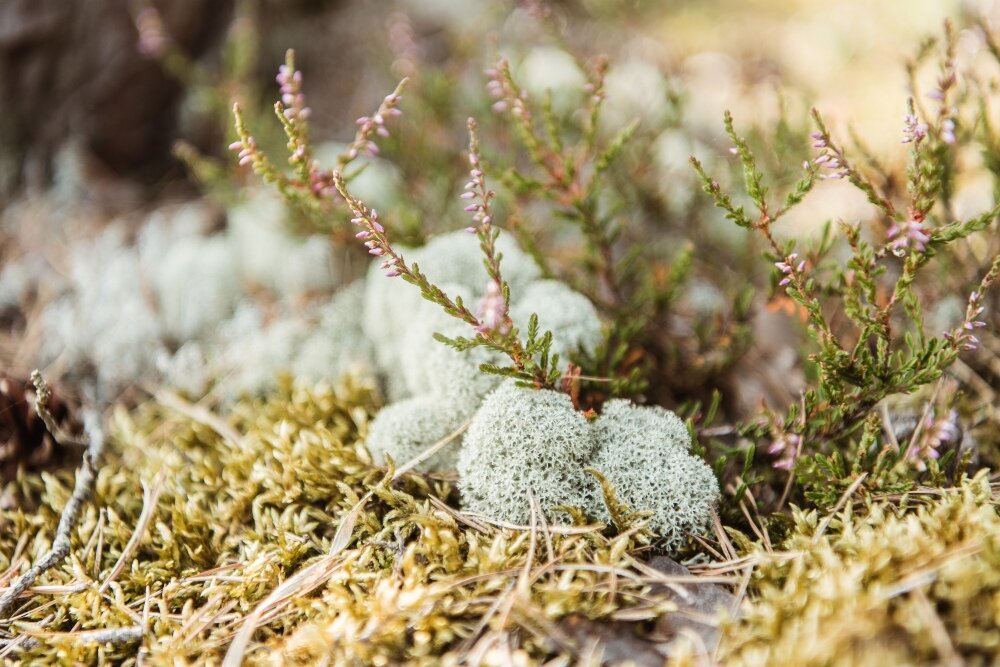
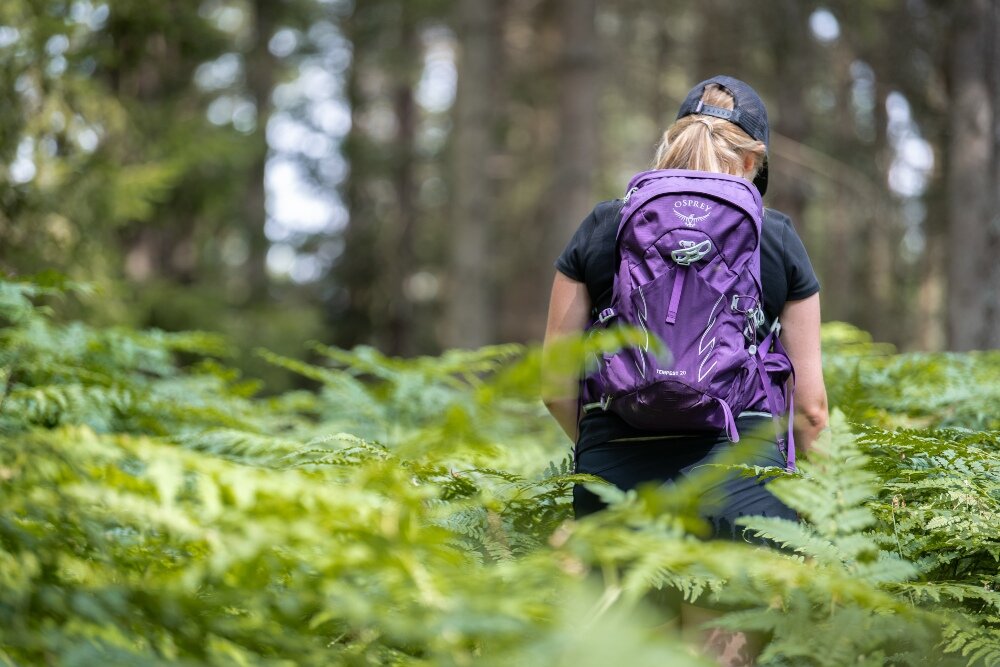
Smoked fennel, charred sweet peppers, baby potatoes with goats cheese crumble, sea salt and wild thyme
Equipment:
Collapsible grill and fire pit
Fire proof gloves
Flint and steel
Dry wood
Sharp knife and chopping board
Plates, knives and forks
Ingredients:
10-12 baby potatoes
1 large bulb of fennel
6-8 baby, sweet peppers
2 tbsp crumbly goats cheese
Pinch of sea salt
Few sprigs of wild thyme
Method:
First, set up your fire, making sure it’s safe to do so.
Once it’s at the right temperature, start with the potatoes.
(Tip: If you want to speed the process, parboil the potatoes in water in advance then finish them on the fire.)
Once the potatoes are cooked, slice the fennel.
Place the fennel and peppers on the grill and allow the skin of the peppers to char. This can be removed after, and gives the peppers a lovely smoky taste.
Chop the potatoes, fennel, and skin the peppers.
Place on plates, top with goats cheese, herbs and sea salt.
Serve.
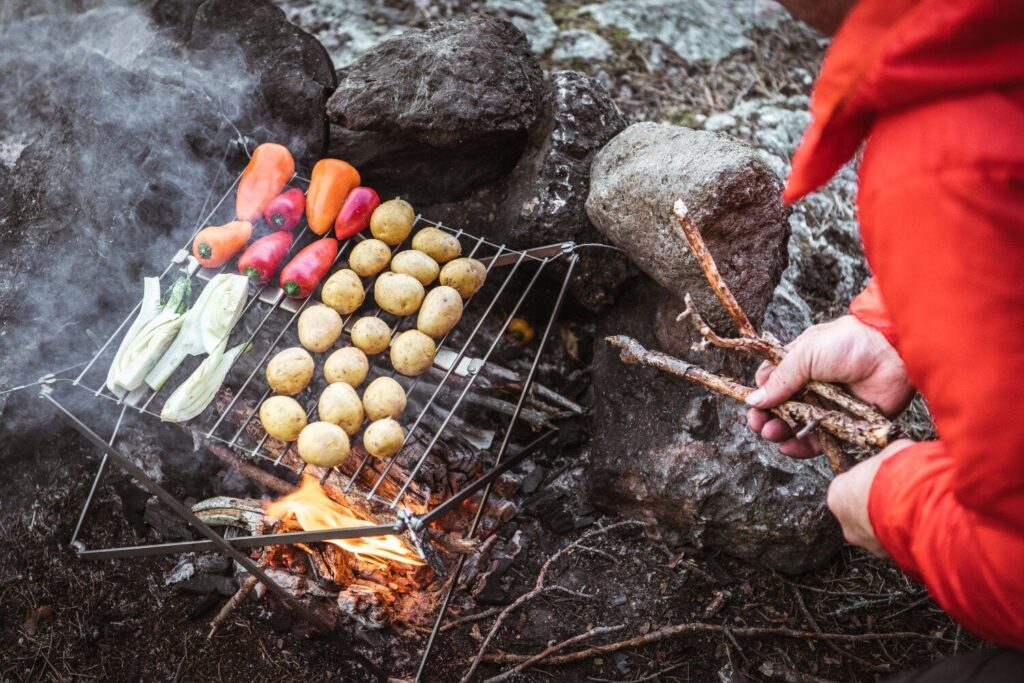
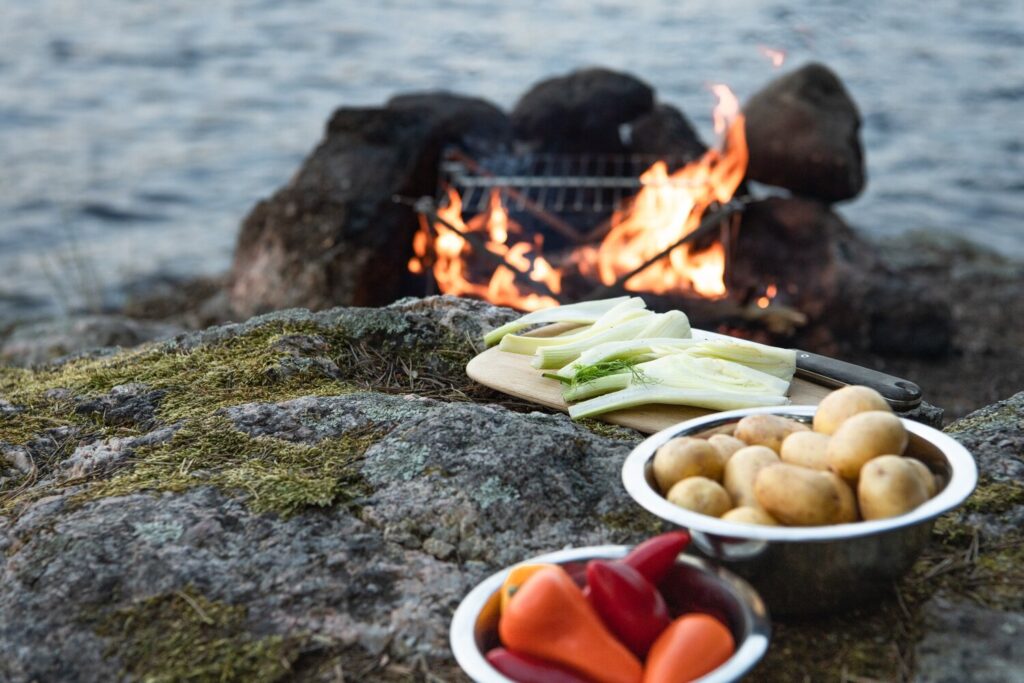
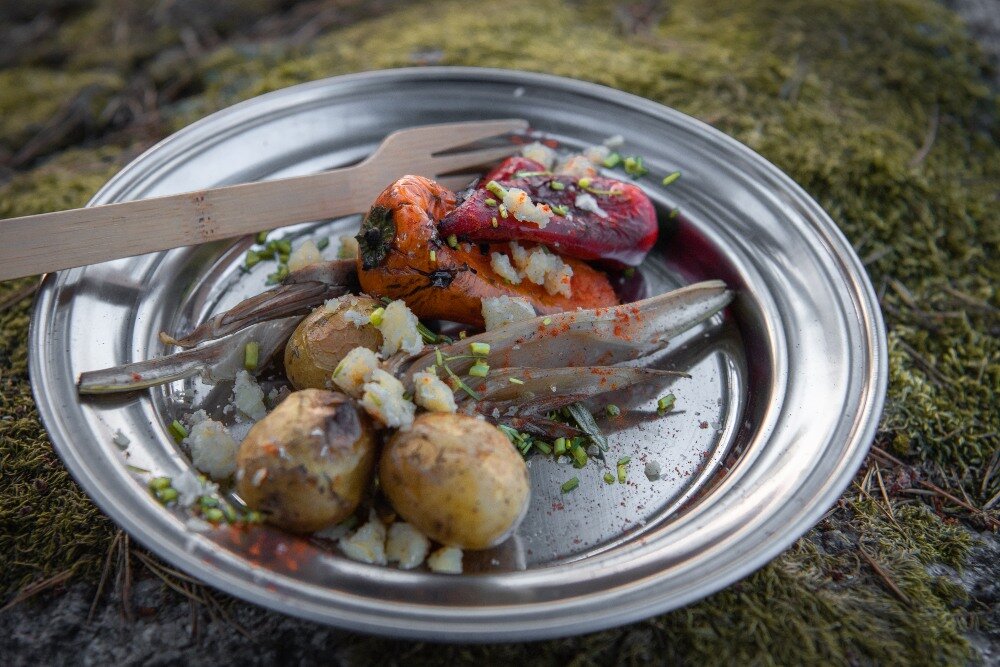
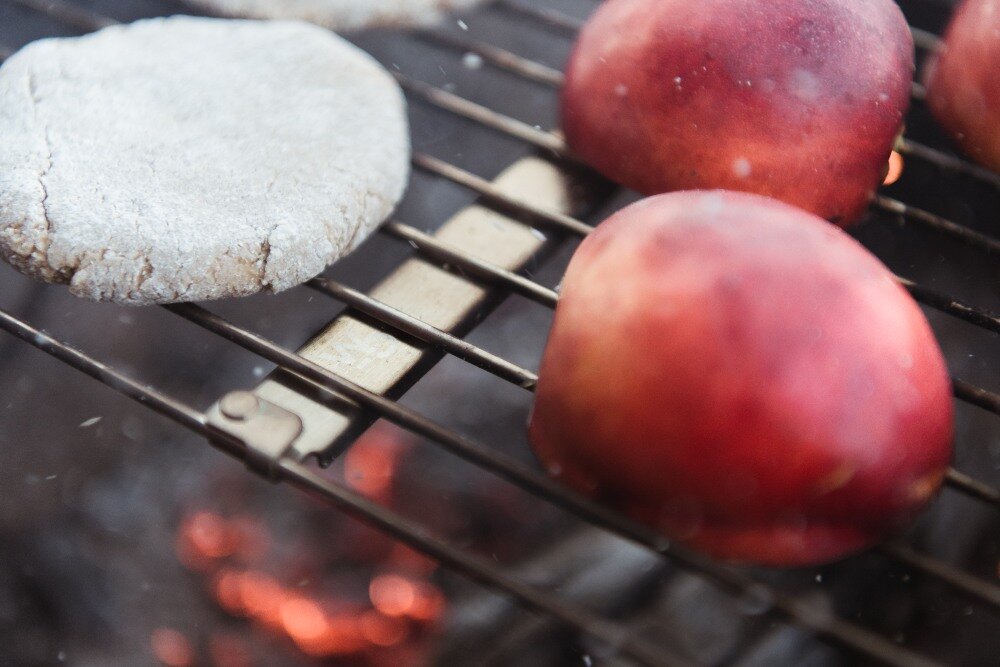
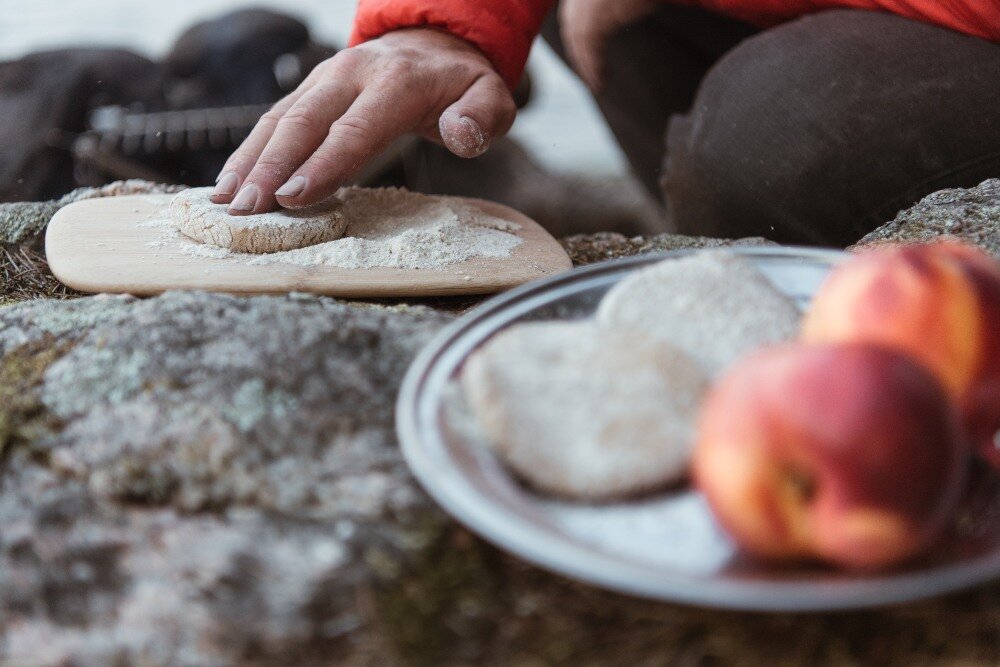
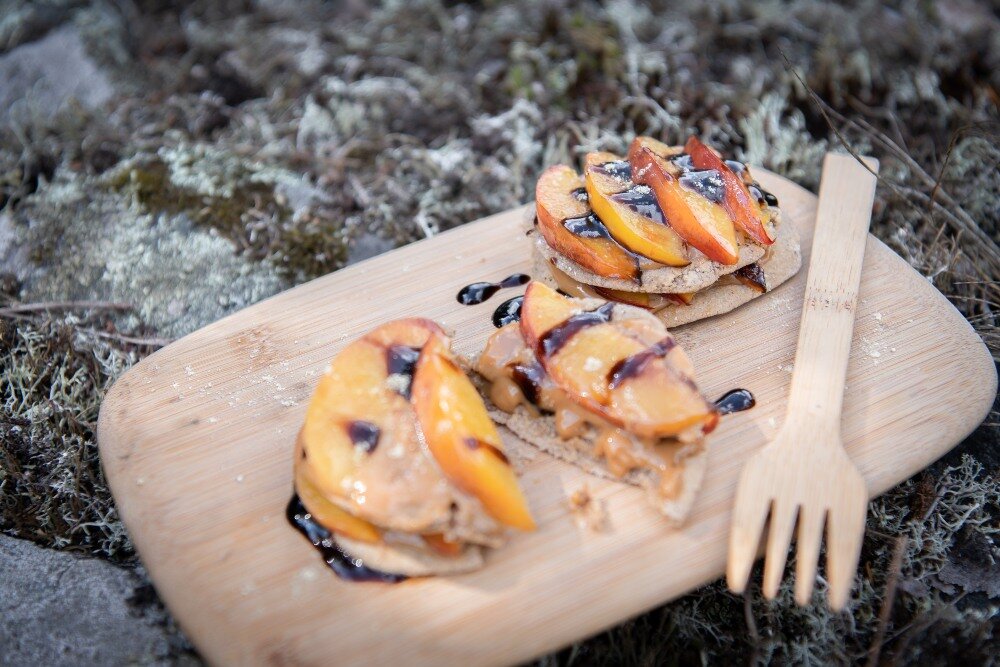
Caramelised nectarines, rough oat cakes with dulce de leche, blueberry balsamic
Ingredients:
150g oat flour + extra for dusting
2 tbsp olive oil
1 tsp sea salt
1 tsp ground black pepper
Water
2 tbsp dulce de leche
2 large nectarines, halved and stoned
2 tsp blueberry balsamic
Equipment:
Small bowl
Collapsible grill and fire pit
Fire proof gloves
Flint and steel
Dry wood
Sharp knife and chopping board
Plates, knives and forks
Method:
Mix the oat flour, salt, pepper and olive oil in a bowl. Slowly add water until you have a thick dough, it should be stiff enough to form a ball.
Dust the chopping board with a little oat flour. Break off a golf ball sized lump of dough, flatten with your hands to a 5mm thick disk and dust again. Repeat until all the dough is used.
Cook the oat cakes on the fire, remembering to flip at least once. While the oat cakes are cooking, place the 4 nectarine halves on the wire grill and cook over the embers until soft and lightly caramelised. Finely slice the nectarines.
To serve:
Place an oat cake on a plate.
Spread a little dulce de leche on the cake.
Top with sliced nectarines.
Add a second layer of oat cake, dulce de leche and nectarine.
Drizzle some blueberry balsamic.
Serve with some espresso.
Don’t miss a single adventure
Sign up to our free newsletter and get a weekly BASE hit to your inbox
Other posts by this author
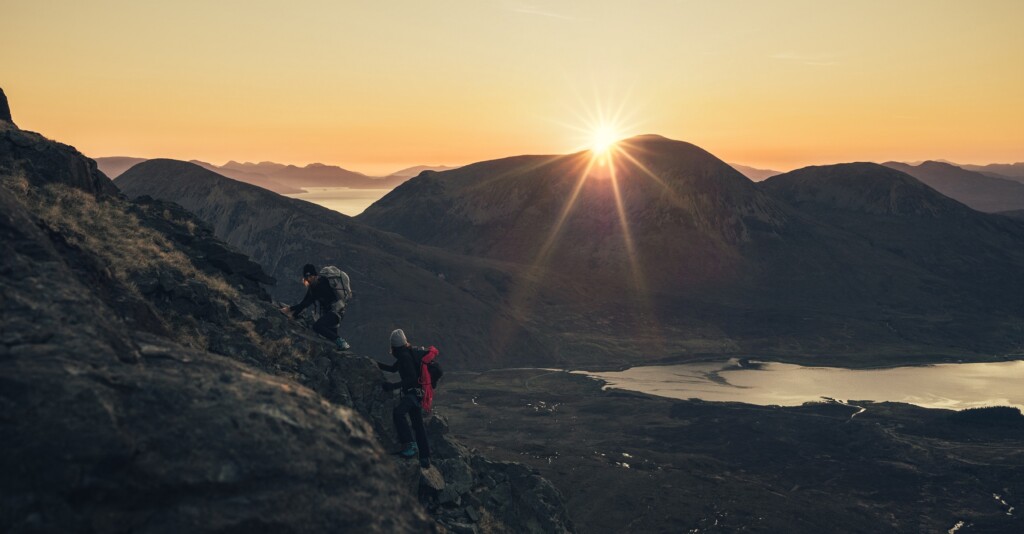
Story • Kieran Creevy • Jun 16, 2023
Scrambling Before Scran on Scotland’s Misty Isle
Sun-drenched ridge lines with expedition chef Kieran Creevy on the Isle of Skye
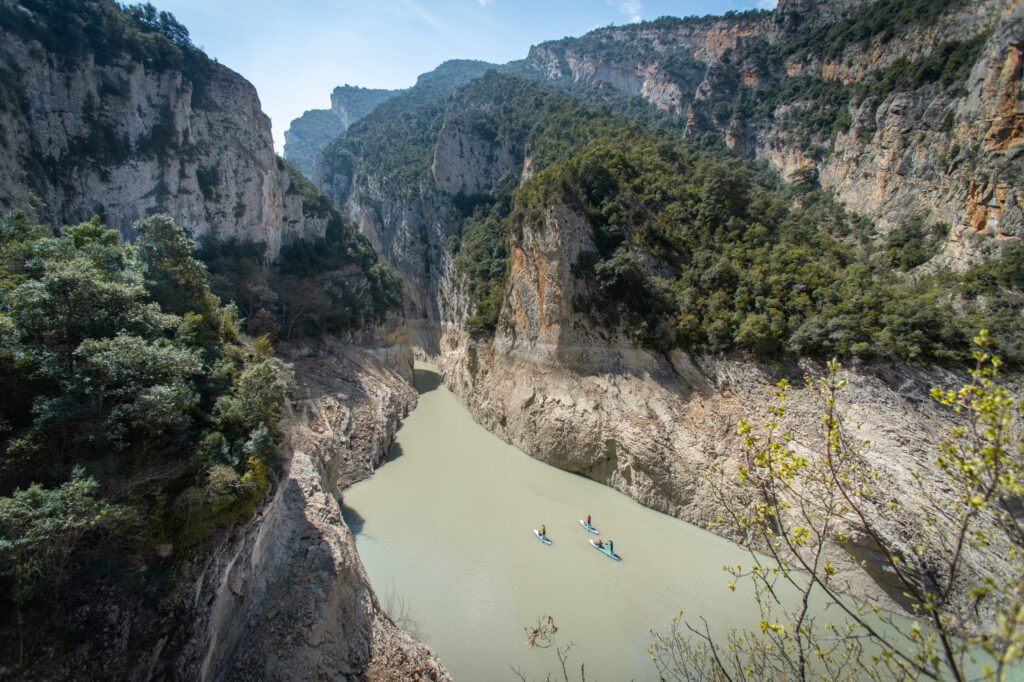
Story • Kieran Creevy • Apr 26, 2022
Echoes from the Canyon
An paddleboard journey through the canyons of Catalonia
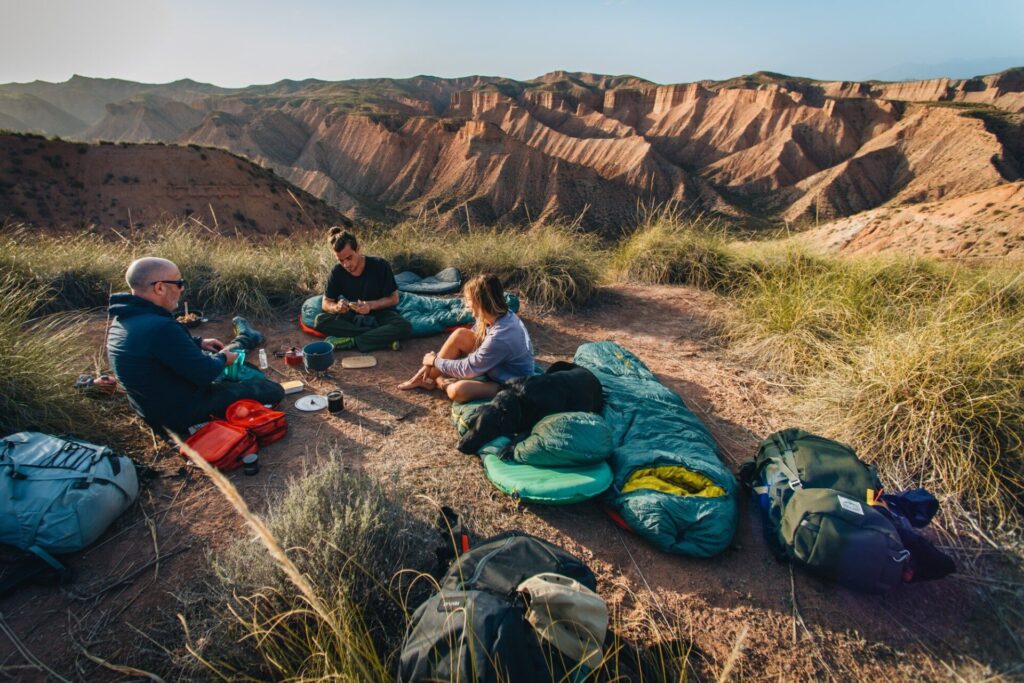
Story • Kieran Creevy • Jun 02, 2021
Desert Heat And Mountain Storms
Exploring the trails and flavours of Andalusia

You might also like
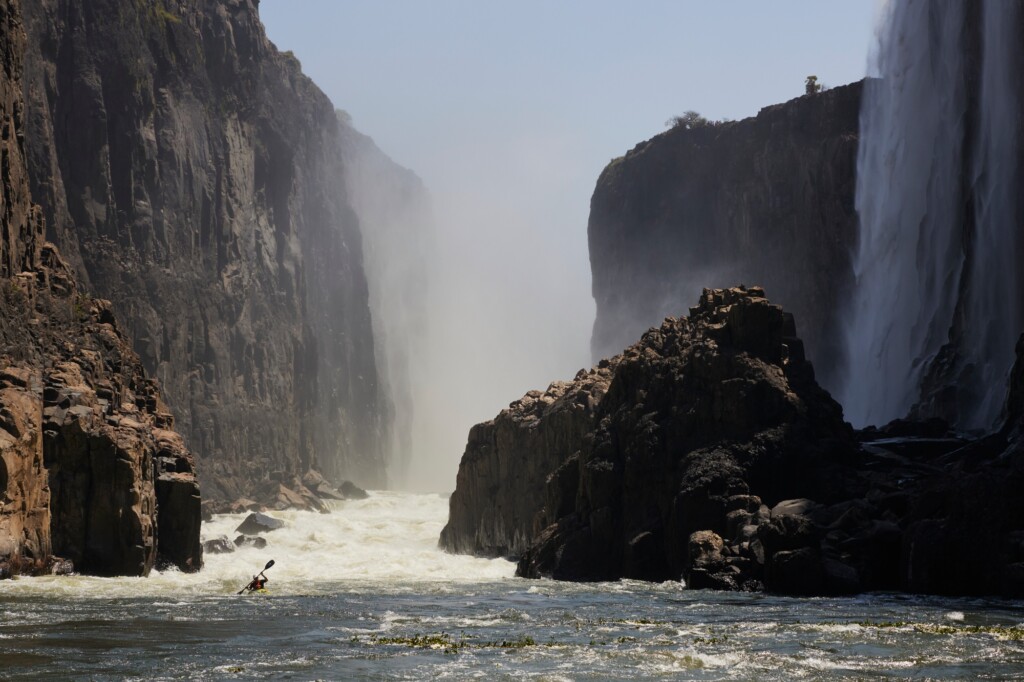
Story • Ed Smith • Jul 26, 2023
Victoria Falls: The Smoke That Thunders
Exploring a personal relationship with the Zambezi and its uncertain future by kayak
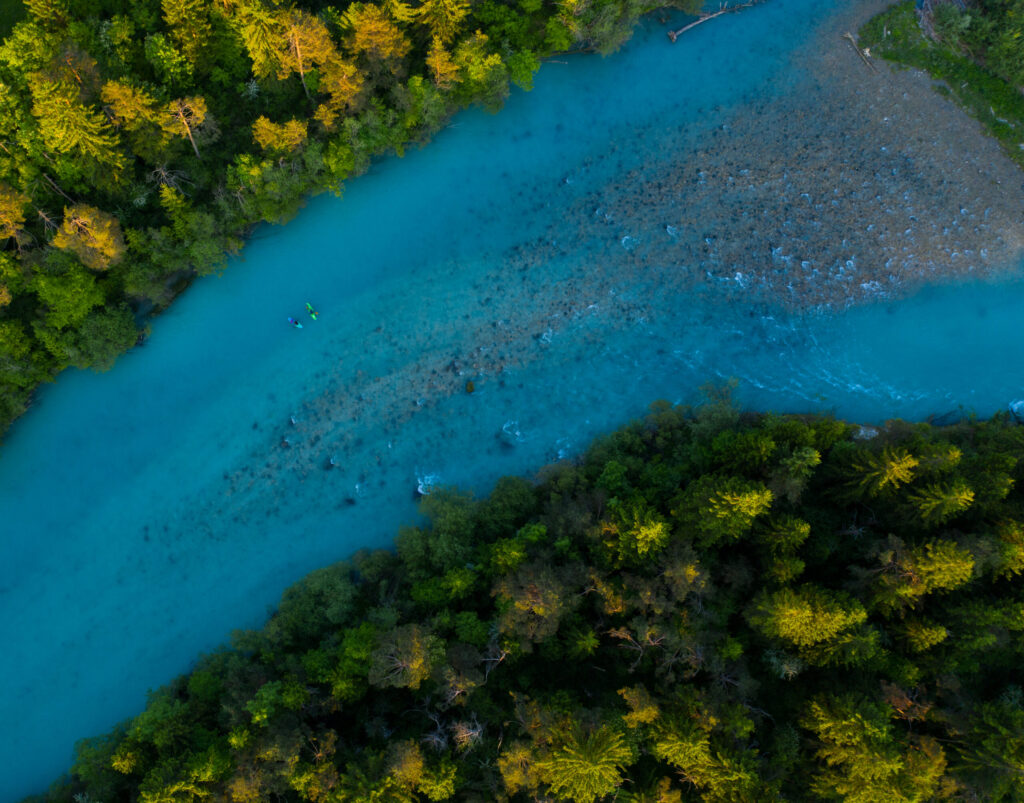
Story • Carmen Kuntz • Feb 18, 2022
One With The River
Whitewater kayaking and environmental action on Slovenia's Sava River
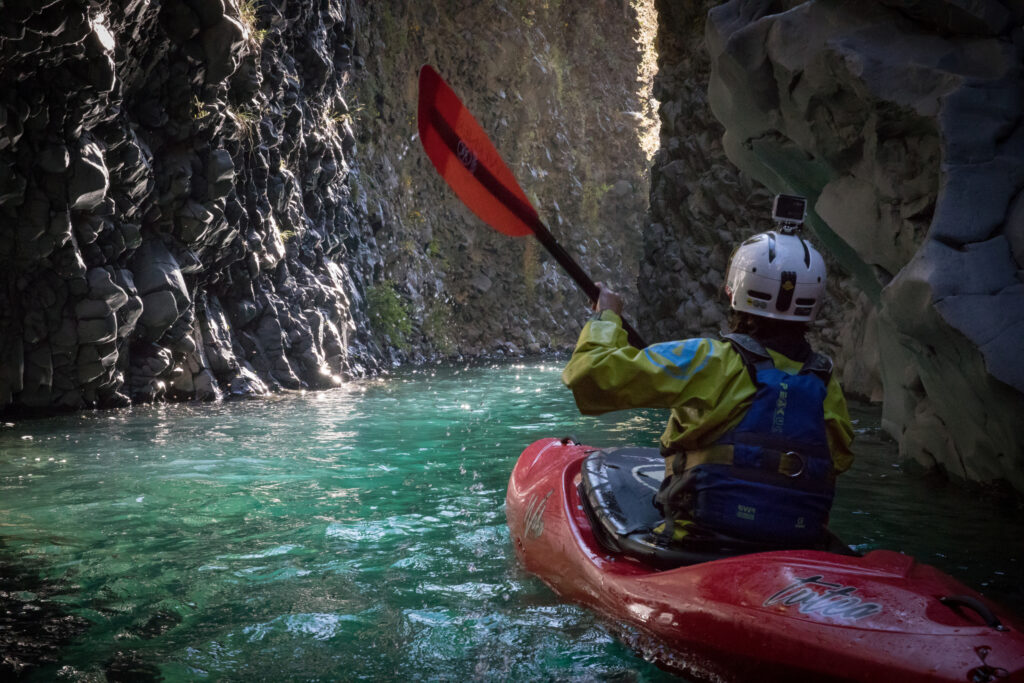
Story • Sal Montgomery • Jan 21, 2022
Pursuit of Place
Finding purpose and community on the wild rivers of Chile
